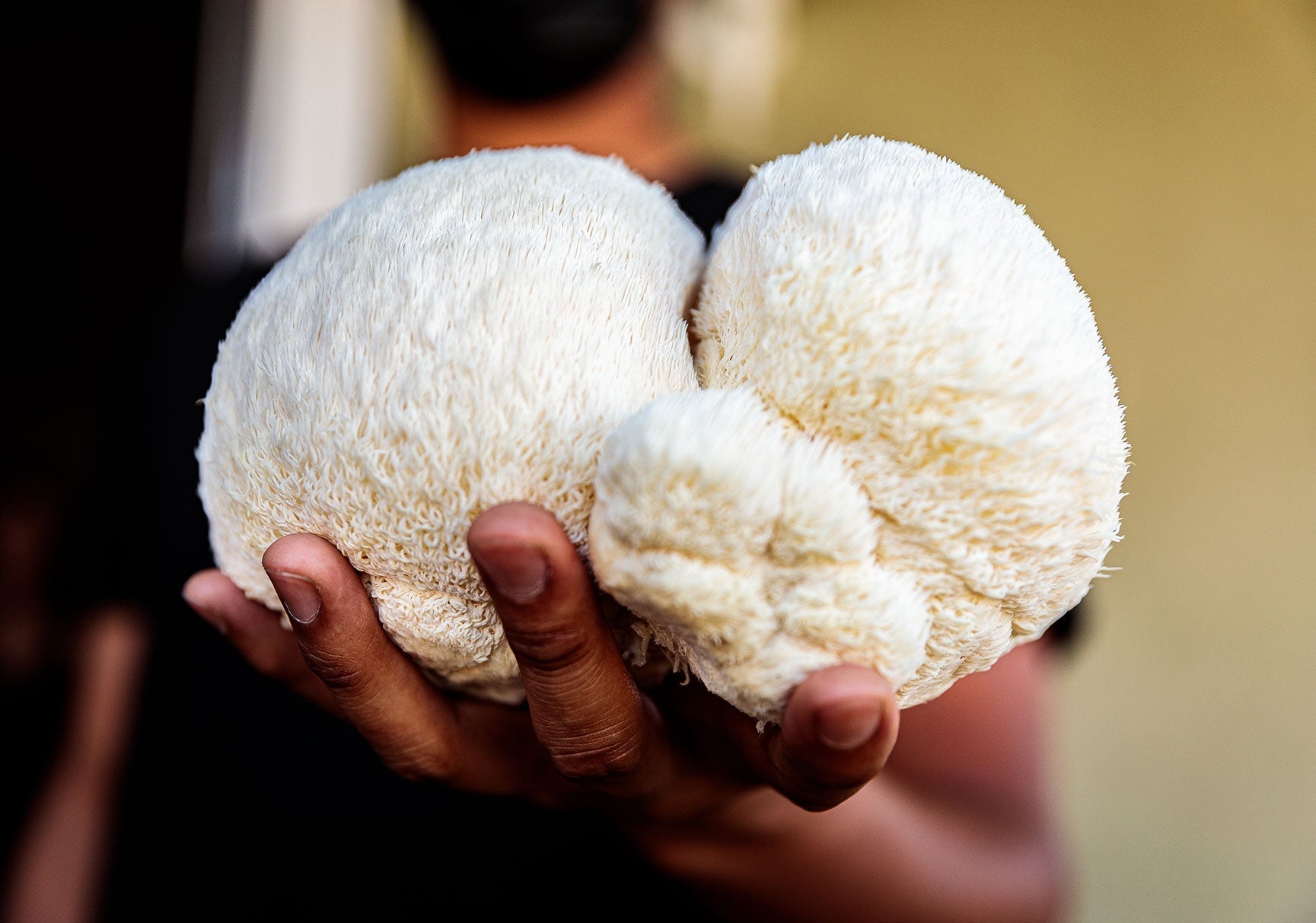Humans have eaten mushrooms for sustenance since well before the earliest history was written.[1] Ancient writings tell us that many fungi species have also been coveted as medicinal treatments for thousands of years.[2]
Lion’s Mane mushroom, scientifically named Hericium erinaceus, is at the top of the functional mushrooms used for centuries in traditional medicine.[2] Western medicine has also begun acknowledging its value, which has fueled its popularity in the local culinary world.[3]
The Edible, Versatile Lion’s Mane
If you’ve ever seen a Lion’s Mane at the market, you know that it doesn’t look like a typical mushroom. In its prime, it looks like a bulbous, white tuft of soft fur, which often grows as large as a cauliflower. Under its fluffy surface is a denser core, which can be sliced or hand-shredded, depending on the texture wanted for a recipe.[3]
The taste of Lion’s Mane can be described as a mild mushroom flavor that easily yields to any recipe's spices. It sometimes has a woody smell, especially if the sample was grown in the wild on rotting tree trunks. When pulled apart, Lion’s Mane flakes into a texture like a crab or fish, often used in vegan dishes as a seafood replacement.[3]
This mushroom is very popular in recipes like:
- Asian stir fry with vegetables and noodles
- Soups like vegan “crab” or mushroom soup
- Pressed and seared in butter like a steak
- Oven roasted with herbs and olive oil
- Sautéed with garlic and tossed into your favorite pasta
- Sliced, seasoned, then broiled as a vegan “hamburger” patty
The imagination only limits the culinary uses for Lion’s Mane. They can be adapted to almost any recipe as a meat substitute or a new favorite side dish.
The Nutritious, Functional Lion’s Mane
Enjoying a Lion’s Mane as food is not its only benefit. Like many mushrooms, it's a good source of nutrients that are essential for good health, including:
- Potassium, which is needed for healthy heart and kidney function, and for muscle contractions.[4,5]
- Biotin, which is a B vitamin, we use to turn food into energy.[4,6]
Fuzzy fungi are also rich in other phytochemicals that may boost human health to the next level. Researchers are finding that Lion’s Mane may be especially helpful for promoting the digestive system and brain health.
Digestive Health
Lion’s Mane mushrooms are a good source of fiber. Most people have heard that fiber improves digestion by providing bulk to stool.[7] Fiber can also help us maintain normal blood sugar levels by slowing digestion.[7] Some special fiber, like the beta-glucan found in Lion’s Mane, also provides food for the good bacteria in your gut. Ultimately, a healthy digestive system is necessary for keeping the rest of our bodies healthy.[8,9]
Brain Health
Some research indicates that Lion’s Mane may support long-term brain health. Animal and human studies have produced evidence that certain compounds called erinacines and hericenones found in mushrooms may help induce brain cell growth. This could help promote normal memory and focus for people who might otherwise struggle.[10]
Lion’s Mane may also stabilize our mental health by protecting us from chronic stress, which can damage the brain and body. Lion’s Mane is an adaptogenic food or a food with properties that help neutralize the effects of stress.[11]
Despite its growing popularity, fresh Lion’s Mane can be difficult to find in most local grocery stores. We offer a convenient way to get the same nutritional benefits from these mushrooms in our delicious gummy supplements. Each strawberry or blueberry-flavored serving provides 500mg of Lion’s Mane extract. Try a bottle today!
References
- Elliott, T. F., Truong, C., Jackson, S. M., Zúñiga, C. L., Trappe, J. M., & Vernes, K. (2022). Fungal Systematics and Evolution, 9, 99–159.
- Valverde, M. E., Hernández-Pérez, T., & Paredes-López, O. (2015). International Journal of Microbiology, 2015, 376387.
- Lion’s Mane mushrooms. (2022, July 13). Mushroom Council. https://www.mushroomcouncil.com/mushroom-101/varieties/lions-mane/
- FoodData is central. (n.d.). Retrieved April 12, 2023, from https://fdc.nal.usda.gov/fdc-app.html#/food-details/1999626/nutrients
- Potassium. (n.d.). Retrieved April 12, 2023, from https://ods.od.nih.gov/factsheets/Potassium-Consumer/
- Biotin. (n.d.). Retrieved April 12, 2023, from https://ods.od.nih.gov/factsheets/Biotin-Consumer/
- Dietary fiber: Essential for a healthy diet. (2022, November 4). Mayo Clinic. https://www.mayoclinic.org/healthy-lifestyle/nutrition-and-healthy-eating/in-depth/fiber/art-20043983
- Diling, C., Chaoqun, Z., Jian, Y., Jian, L., Jiyan, S., Yizhen, X., & Guoxiao, L. (2017). Frontiers in Immunology, 8, 666.
- Sheng, X., Yan, J., Meng, Y., Kang, Y., Han, Z., Tai, G., Zhou, Y., & Cheng, H. (2017). Food & Function, 8(3), 1020–1027.
- Ma, B.-J., Shen, J.-W., Yu, H.-Y., Ruan, Y., Wu, T.-T., & Zhao, X. (2010). Mycology, 1(2), 92–98.
- Panossian, A. (2017). Annals of the New York Academy of Sciences, 1401(1), 49–64.

